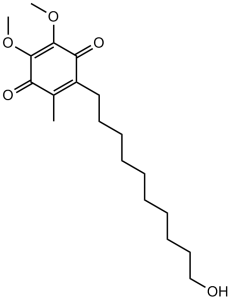Idebenone (CV-2619)
This product is for research use only, not for human use. We do not sell to patients.

For small sizes, please check our retail website as below: www.invivochem.com
| Size | Price | Stock |
|---|---|---|
| 2g | $330 | Check With Us |
| 10g | $960 | Check With Us |
| 20g | $1440 | Check With Us |
Cat #: V2310 CAS #: 58186-27-9 Purity ≥ 98%
Description: Idebenone (also known as CV-2619) is a synthetic analog of coenzyme Q10 (CoQ10) and a brain stimulant.
Top Publications Citing Invivochem Products
Publications Citing InvivoChem Products
Product Promise

- Physicochemical and Storage Information
- Protocol
- Related Biological Data
- Stock Solution Preparation
- Quality Control Documentation
| Molecular Weight (MW) | 338.44 |
|---|---|
| Molecular Formula | C19H30O5 |
| CAS No. | 58186-27-9 |
| Storage | -20℃ for 3 years in powder formr |
| -80℃ for 2 years in solvent | |
| Solubility In Vitro | DMSO: 68 mg/mL (200.9 mM)r |
| Water: <1 mg/mLr | |
| Ethanol: 68 mg/mL (200.9 mM) | |
| SMILES Code | O=C(C(OC)=C1OC)C(C)=C(CCCCCCCCCCO)C1=O |
| Synonyms | CV-2619; CV 2619; CV2619; Catena, Raxone, Sovrima |
| Protocol | In Vitro | Idebenone (oxidised form) inhibits total arachidonic acid metabolism, cyclooxygenase metabolism, lipoxygenase metabolism, lipoxygenase/cyclooxygenase with IC50s of 16.65±3.48, 14.44±2.99, 46.51±7.20, and 3.22 μM. Idebenone (oxidised form) behaves similarly as indomethacin and piroxicam—two typical anti-inflammatory agents. Idebenone (oxidised form) preferentially inhibits cyclooxygenase vs. lipoxygenase metabolism (IC50 ratio lipoxygenase/cyclooxygenase: 3.22). Idebenone, a compound with protective efficacy against neurotoxicity both in in vitro and in in vivo models, exists in two different oxidative states: the ubiquinol-derivative (reduced idebenone) and the ubiquinone-derivative (oxidised idebenone). |
|---|---|---|
| In Vivo | Idebenone (oxidised form) is a compound with protective efficacy against cerebrovascular disorders in vivo, including cerebral ischemia and hypertension-induced vascular lesions. |
These protocols are for reference only. InvivoChem does not
independently validate these methods.
| Solvent volume to be added | Mass (the weight of a compound) | |||
|---|---|---|---|---|
| Mother liquor concentration | 1mg | 5mg | 10mg | 20mg |
| 1mM | 2.9547 mL | 14.7737 mL | 29.5473 mL | 59.0947 mL |
| 5mM | 0.5909 mL | 2.9547 mL | 5.9095 mL | 11.8189 mL |
| 10mM | 0.2955 mL | 1.4774 mL | 2.9547 mL | 5.9095 mL |
| 20mM | 0.1477 mL | 0.7387 mL | 1.4774 mL | 2.9547 mL |
The molarity calculator equation
Mass(g) = Concentration(mol/L) × Volume(L) × Molecular Weight(g/mol)
Mass
=
Concentration
×
Volume
×
Molecular Weight*
The dilution calculator equation
Concentration(start)
×
Volume(start)
=
Concentration(final)
×
Volume(final)
This equation is commonly abbreviated as: C1 V1 = C2 V2
Concentration(start)
C1
×
Volume(start)
V1
=
Concentration(final)
C2
×
Volume(final)
V2
Step One: Enter information below
Dosage mg/kg
Average weight of animals g
Dosing volume per animal µL
Number of animals
Step Two: Enter the in vivo formulation
%DMSO
+
%
+
%Tween 80
+
%ddH2O
Calculation Results:
Working concentration:
mg/ml;
Method for preparing DMSO master liquid:
mg
drug pre-dissolved in
µL
DMSO(Master liquid concentration
mg/mL)
,Please contact us first if the concentration exceeds the DMSO solubility of the batch of drug.
Method for preparing in vivo formulation:
Take
µL
DMSO master liquid, next add
µL
PEG300, mix and clarify, next add
µL
Tween 80,mix and clarify, next add
µL
ddH2O,mix and clarify.
Note:
- (1) Please be sure that the solution is clear before the addition of next solvent. Dissolution methods like vortex, ultrasound or warming and heat may be used to aid dissolving.
- (2) Be sure to add the solvent(s) in order.




































